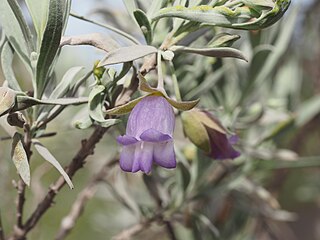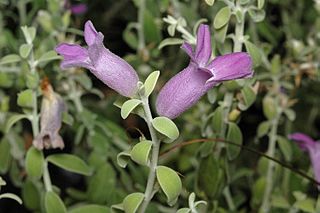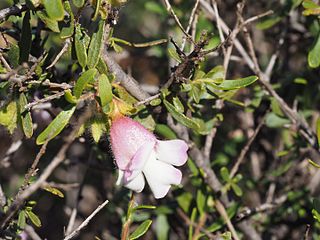
Eremophila maitlandii, commonly known as Shark Bay poverty bush, is a flowering plant in the figwort family, Scrophulariaceae and is endemic to Western Australia. It is a silvery-grey shrub with linear leaves and lilac-coloured to light purple flowers and is common in coastal areas between Shark Bay and Carnarvon.

Eremophila strongylophylla is a flowering plant in the figwort family, Scrophulariaceae and is endemic to Western Australia. It is a small shrub with distinctive round leaves, yellowish new growth and purple flowers which are white inside. It is similar to Eremophila mackinlayi and Eremophila hygrophana but distinguished from them by characteristics including leaf shape, and the type of hairs on its leaves and branches.

Eremophila caespitosa, commonly known as felty-leaved eremophila, is a flowering plant in the figwort family, Scrophulariaceae and is endemic to an area near the centre of Western Australia. It is a small shrub with a tuft-like habit, very hairy grey leaves and lilac to purple flowers.
Eremophila cordatisepala is a flowering plant in the figwort family, Scrophulariaceae and is endemic to areas of Queensland and the Northern Territory in Australia. It is a small grey shrub with purple to lilac-coloured flowers which have heart-shaped sepals at their base.

Eremophila decussata is a flowering plant in the figwort family, Scrophulariaceae and is only known from several small, disjunct areas in Western Australia and South Australia. It is small, spreading, silvery-grey shrub with soft leaves and lilac-coloured flowers with spots or streaks of purple inside the flower.
Eremophila eversa is a flowering plant in the figwort family, Scrophulariaceae and is endemic to a restricted area of Western Australia. It is known from only one plant, now thought to have died. It is a small shrub with small leaves and hairy purple to lilac-coloured flowers.
Eremophila falcata is a flowering plant in the figwort family, Scrophulariaceae and is endemic to Western Australia. It is a widely distributed shrub with distinctive curved leaves and white, lilac-coloured or pink flowers.
Eremophila hispida is a flowering plant in the figwort family, Scrophulariaceae and is endemic to Queensland. It is a small shrub with narrow, hairy, clustered leaves, with violet to purple flowers and is restricted to a small area in central Queensland.
Eremophila lanata is a flowering plant in the figwort family, Scrophulariaceae and is endemic to Western Australia. It is a small shrub with small, hairy leaves, densely hairy sepals and lilac to pinkish flowers.
Eremophila papillata is a flowering plant in the figwort family, Scrophulariaceae and is endemic to Western Australia. It is an erect, compact shrub with sticky, narrow leaves and mauve, blue or purple, rarely white flowers.
Eremophila pendulina is a flowering plant in the figwort family, Scrophulariaceae and is endemic to Western Australia. It is a tall, spindly, weeping shrub with narrow leaves and purple, mauve or white flowers in autumn and early spring.

Eremophila phyllopoda is a flowering plant in the figwort family, Scrophulariaceae and is endemic to Western Australia. It is an erect or spreading shrub, sometimes round or flat-topped with sticky, hairy leaves and flowers ranging in colour from pink or lilac to purple.
Eremophila pilosa is a flowering plant in the figwort family, Scrophulariaceae and is endemic to Western Australia. It is a small shrub with many tangled branches, with its leaves and branches densely covered with hairs and which has mauve or purple flowers. It occurs in a restricted area in the Pilbara.

Eremophila pungens is a flowering plant in the figwort family, Scrophulariaceae and is endemic to Australia. It is an erect, sticky shrub with broad, serrated-edged leaves which end in a sharp spine and purple or violet flowers.
Eremophila revoluta is a flowering plant in the figwort family, Scrophulariaceae and is endemic to Western Australia. It is a low, dense shrub with small, hairy leaves, very hairy sepals and mauve or purple petals.

Eremophila rhegos is a flowering plant in the figwort family, Scrophulariaceae and is endemic to Western Australia. It is an erect shrub with densely hairy leaves and branches and blue, mauve, purple or white flowers.

Eremophila rigens is a flowering plant in the figwort family, Scrophulariaceae and is endemic to Western Australia. It is an erect shrub with long, stiff, glabrous leaves and pale lilac-coloured to white flowers.

Eremophila spinescens is a flowering plant in the figwort family, Scrophulariaceae and is endemic to Western Australia. It is a low, spreading, rigid, spiny shrub with small leaves and lilac to dark purple flowers.

Eremophila ternifolia, commonly known as Wongan eremophila is a flowering plant in the figwort family, Scrophulariaceae and is endemic to Western Australia. It is a low, many-branched, shrub with short, pointed leaves and small lilac-coloured or mauve flowers.

Eremophila warnesii is a flowering plant in the figwort family, Scrophulariaceae and is endemic to Western Australia. It is an erect, compact shrub with furry leaves, hairy sepals and blue to mauve petals. It is a little-known species, named after the founder of the Eremophila Study Group.













